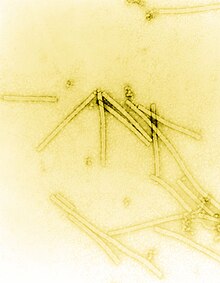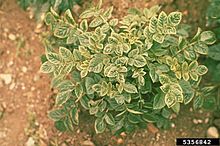植物病毒
植物病毒(Plant virus)泛指感染植物的病毒,大多为正单链RNA病毒[1],一般不具有外膜(布尼亚病毒目与单股反链病毒目的病毒则有)[2],有许多外观呈棒状[3],也有呈正多面体者,其中双生病毒科的病毒由双生的两个正二十面体组成。植物病毒在自然界中大多以动物媒介、花粉或种子传播,较少如动物病毒般以直接接触传染,动物媒介包括昆虫、线虫与蜘蛛等,其中以昆虫居多(特别是半翅目昆虫),有些病毒可进入昆虫的血腔中,使其终生具备散播病毒的能力,有些病毒并可影响宿主花朵的特性以吸引或阻止昆虫前来[4]。植物可以植物激素(水杨酸、茉莉酸与脱落酸等[5])启动抗病毒反应,并以RNA干扰等机制清除病毒RNA[6],而病毒也有许多机制对抗宿主免疫反应,例如形成膜结构以避免被宿主核酸酶切割[1],并可利用植物透过胞间连丝在细胞间传递mRNA的机制传播自己的RNA[7]。






许多粮食作物与经济作物可被植物病毒感染[8],如玉米褪绿斑驳病毒、大麦黄矮病毒、小麦线条花叶病毒、水稻东格鲁病毒、马铃薯Y病毒、甘薯褪绿矮化病毒(sweet potato chlorotic stunt virus)、番茄褐色皱果病毒、胡瓜绿斑嵌纹病毒等,可能影响粮食安全[9],估计每年在全世界造成超过600亿美元的经济损失[10],不过许多植物病毒的感染并不造成任何症状,甚至可与植物互利共生,例如圆叶烟草被许多病毒感染后可提升对缺水逆境的抗性;有些植物还可将病毒的基因用作其他功能,如白三叶草潜隐病毒(clover cryptic virus)的衣壳蛋白被一些植物用于抑制根瘤的形成[11]。
历史上第一种被发现的病毒烟草花叶病毒(TMV)即为植物病毒[12]。有些植物病毒在科学研究或农业上具有应用价值,在生物学研究中,有些植物病毒可被研究人员用作载体将遗传物质送入植物细胞中[13];有些园艺植物被病毒感染可提升其价值,如十七世纪荷兰的郁金香狂热中,被郁金香条斑病毒感染的郁金香花朵上有不同颜色的条纹,因此价格非常高昂[14];有些植物病毒则因能杀伤杂草或害虫而可用于生物防治[15][16]。
分类
编辑有约30个科的病毒可感染植物,其中有些科的病毒皆为植物病毒,有些则包含感染动物、真菌等其他生物的病毒。许多植物病毒与真菌病毒或感染节肢动物的病毒关系接近,有些植物病毒可在真菌细胞内复制,也有些真菌病毒可在植物细胞内复制,此现象可能与陆生植物和真菌的共生关系有关[4]。
双股RNA病毒
编辑反义单股RNA病毒
编辑逆转录病毒
编辑- 花椰菜病毒科 Caulimoviridae
正义单股RNA病毒
编辑- 甲型线形病毒科 Alphaflexiviridae
- 乙型线形病毒科 Betaflexiviridae
- 芜菁发黄花叶病毒科 Tymoviridae
- 伴生豇豆病毒科 Secoviridae
- 甜菜坏死黄脉病毒科 Benyviridae
- 雀麦花叶病毒科 Bromoviridae
- 修道院病毒科 Closteroviridae
- 蒂状病毒科 Virgaviridae
- 黄症病毒科 Luteoviridae
- Solemoviridae
- 番茄丛矮病毒科 Tombusviridae
- 葡萄孢菌乌尔米耶病毒科
地位未定
- 烟草花叶卫星病毒属 Virtovirus
- 黍花叶卫星病毒属 Papanivirus
- 绿萝卫星病毒属 Aumaivirus
- Blunervirus
- 柑橘粗糙病毒属 Cilevirus
- 木槿绿斑病毒属 Higrevirus
- 悬钩子病毒属 Idaeovirus
单股DNA病毒
编辑参考文献
编辑- ^ 1.0 1.1 Hyodo K, Hashimoto K, Kuchitsu K, Suzuki N, Okuno T. Harnessing host ROS-generating machinery for the robust genome replication of a plant RNA virus.. Proc Natl Acad Sci U S A. 2017, 114 (7): E1282–E1290. PMC 5320965 . PMID 28154139. doi:10.1073/pnas.1610212114.
- ^ Ibrahim A, Odon V, Kormelink R. Plant Viruses in Plant Molecular Pharming: Toward the Use of Enveloped Viruses.. Front Plant Sci. 2019, 10: 803. PMC 6594412 . PMID 31275344. doi:10.3389/fpls.2019.00803.
- ^ Roossinck, M. J. The good viruses: viral mutualistic symbioses. Nature Reviews Microbiology. 2011, 9 (2): 99–108. PMID 21200397. doi:10.1038/nrmicro2491.
- ^ 4.0 4.1 Lefeuvre P, Martin DP, Elena SF, Shepherd DN, Roumagnac P, Varsani A. Evolution and ecology of plant viruses.. Nat Rev Microbiol. 2019, 17 (10): 632–644. PMID 31312033. doi:10.1038/s41579-019-0232-3.
- ^ Zhao S, Li Y. Current understanding of the interplays between host hormones and plant viral infections.. PLoS Pathog. 2021, 17 (2): e1009242. PMC 7906326 . PMID 33630970. doi:10.1371/journal.ppat.1009242.
- ^ Blevins T, Rajeswaran R, Shivaprasad PV, Beknazariants D, Si-Ammour A, Park HS, Vazquez F, Robertson D, Meins F, Hohn T, Pooggin MM. Four plant Dicers mediate viral small RNA biogenesis and DNA virus induced silencing. Nucleic Acids Research. 2006, 34 (21): 6233–46. PMC 1669714 . PMID 17090584. doi:10.1093/nar/gkl886.
- ^ Oparka KJ, Alison GR. Plasmodesmata. A Not So Open-and-Shut Case. Plant Physiology. 2001, 125: 123–126.
- ^ Jones RAC, Naidu RA. Global Dimensions of Plant Virus Diseases: Current Status and Future Perspectives.. Annu Rev Virol. 2019, 6 (1): 387–409. PMID 31283443. doi:10.1146/annurev-virology-092818-015606.
- ^ Jones RAC. Global Plant Virus Disease Pandemics and Epidemics.. Plants (Basel). 2021, 10 (2). PMC 7911862 . PMID 33504044. doi:10.3390/plants10020233.
- ^ Plant viruses may be reshaping our world. Science Daily. 2019-07-17 [2021-04-27]. (原始内容存档于2021-06-05).
- ^ Roossinck MJ. The good viruses: viral mutualistic symbioses.. Nat Rev Microbiol. 2011, 9 (2): 99–108. PMID 21200397. doi:10.1038/nrmicro2491.
- ^ Lecoq H. [Discovery of the first virus, the tobacco mosaic virus: 1892 or 1898?].. C R Acad Sci III. 2001, 324 (10): 929–33. PMID 11570281. doi:10.1016/s0764-4469(01)01368-3 (法语).
- ^ Abrahamian, Peter; Hammond, Rosemarie W.; Hammond, John. Plant Virus-Derived Vectors: Applications in Agricultural and Medical Biotechnology. Annual Review of Virology. 2020-06-10, 7. ISSN 2327-0578. PMID 32520661. doi:10.1146/annurev-virology-010720-054958.
- ^ Garber, Peter M. Tulipmania. Journal of Political Economy. 1989, 97 (3): 535-560.
- ^ Harding, Dylan P.; Raizada, Manish N. Controlling weeds with fungi, bacteria and viruses: a review. Frontiers in Plant Science. 2015, 6: 659. ISSN 1664-462X. PMC 4551831 . PMID 26379687. doi:10.3389/fpls.2015.00659.
- ^ Bonning, Bryony C.; Pal, Narinder; Liu, Sijun; Wang, Zhaohui; Sivakumar, S.; Dixon, Philip M.; King, Glenn F.; Miller, W. Allen. Toxin delivery by the coat protein of an aphid-vectored plant virus provides plant resistance to aphids. Nature Biotechnology. January 2014, 32 (1): 102–105. ISSN 1546-1696. PMID 24316580. doi:10.1038/nbt.2753.